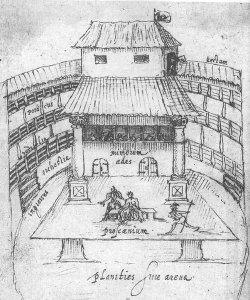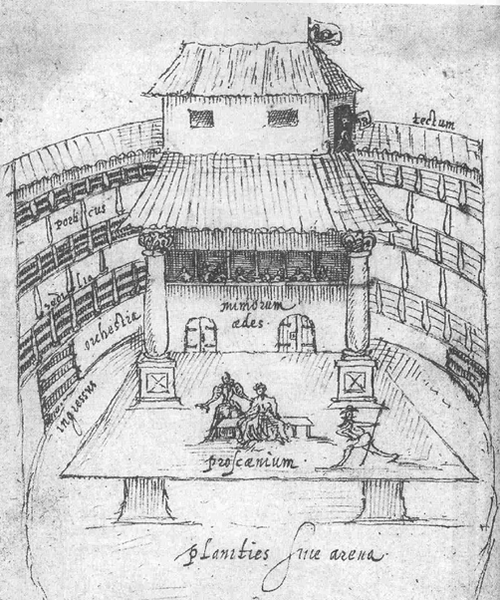As yesterday (April 23) was William Shakespeare’s unofficial birthday, I thought I’d write a bit about props and Shakespeare. At the Public Theatre here in New York City, we’re starting to gear up for Shakespeare in the Park, starting with Twelfth Night. It will feature Anne Hathaway (the Bride Wars star, not Shakespeare’s wife).
A lot of what we know about props in Shakespearean times comes from Henslowe’s Diary, which incidentally, never once mentions William Shakespeare. It does, however, contain a detailed record of the day-to-day theatre business of Philip Henslowe, a theatrical entrepreneur involved in nearly all aspects of the Elizabethan stage. Included in his diary is an inventory of “all the properties for my Lord Admiral’s Men, the 10 of March 1598:
Item, 1 rock, 1 cage, 1 tomb, 1 Hell mouth… 1 bedstead.
Item, 8 lances, 1 pair of stairs for Phaethon.
Item, 1 globe, & 1 golden sceptre; 3 clubs
Item, 1 golden fleece, 2 racquets, 1 bay tree.
Item, 1 lion’s skin, 1 bear’s skin; Phaethon’s limbs, & Phaethon’s chariot, & Argus’s head.
Item, Iris’s head, & rainbow; 1 little altar. . .
1 ghost’s gown; 1 crown with a sun.”
You can see many typical props here. Furniture, weapons, and set decoration all appear on the list. Heads are another common prop made by prop shops. The list also contains what we would consider small set pieces. As Elizabethan theatre had no “background” scenery, it made sense for a set of stairs to be made and maintained by the same person or people who made and kept track of the bedstead.
It is a fairly straightforward props list. When you read a Shakespeare play, the stage directions will be pretty explicit about what props his actors probably used. In Romeo and Juliet, when it is written that Juliet “snatches Romeo’s dagger”, it most certainly meant she (technically, he) grabbed a prop dagger, rather than miming the action. The style and construction of the dagger is less certain, though many scholars contend it would have been an Elizabethan dagger, rather than a more historically or geographically accurate one. In other words, the dagger in Julius Caesar would have been the same dagger as in Romeo and Juliet, which would have been similar to the daggers carried by the audience.
Perhaps one of the most problematic stage directions is The Winter’s Tale‘s “exit pursued by a bear”. Without uncovering new archaeological evidence, we will probably never know whether a real bear was used or not. But for the rest of the props, between Henslow’s diary, and de Witt’s drawing of the Swan theatre (pictured below), we get a good overview of props in Shakespeare’s time: weapons, furniture, minor set decoration and small set pieces, and fake (I hope) body parts.
You can find more about Henslowe’s Diary by perusing the public domain Henslow’s Diary Companion on Google Books. I also found a great deal of information at Internet Shakespeare. If you click around, you’ll find an archive of Shakespeare in Performance, including an archive of artifacts from past performances of Shakespeare’s plays. This includes not only drawings and photographs, but also props lists, scene breakdowns, and other production notes.







Ah, now we’re in my territory…. Henslowe’s diary doesn’t mention Shakespeare because he was the manager for the rival theater. He was pretty much obsessed with the money/business aspect of the playhouse which is why he kept such detailed diaries. He does mention a bunch of Shakespeare’s plays (and possibly paid people to plagiarize Shakespeare’s works)
Some scholars theorize that the bear could easily have been a bear skin worn by an actor (like throwing a bear skin rug over your back) since bears would have been readily available (bear baiting).
You’re right that the daggers would have been Elizabethan and not historically accurate. They did everything in Elizabethan dress (the Peachum drawing shows a production of Titus where the actors are wearing togas over their clothes…)
If you want to read more about the staging practices try picking up anything by Andrew Gurr. Also, Blackfriars Playhouse in VA does their shows in rep so you could go for a weekend and experience three productions (all done with original practices).
excellent results !!!!!!!!!!
only to say